Explainer
Integrating AI into the (Ad) Creative Process
by Jacob Trussell11 min read
Abstract
- Generative artificial intelligence programs like ChatGPT and Midjourney are revolutionizing the creative process.
- This revolution may be causing anxiety within the lives of creative marketers, from copywriters to graphic designers.
- But AI is only a tool, not a replacement, for the creative humans that exist in your teams.
Ask Google about artificial intelligence (AI) and the creative process, and you’ll be treated to an assortment of doomer-adjacent headlines:
- “Is AI a Risk To Creativity? The Answer Is Not So Simple”
- “When AI can make art – what does it mean for creativity?”
- “How AI is radically changing our definition of human creativity”
- “How Generative AI is redefining the creative process”
As creative marketers ourselves, we understand the anxiety others within our niche may be experiencing at this moment. When a hot new tool comes out that can accomplish tasks traditionally done by copywriters and graphic designers, it’s natural to feel a little threatened. If the work we do can now be done with a few clicks and text prompts, what does that mean for the future of not just the industry – but our jobs? And in an era when many companies are cutting costs by shrinking their workforce, the emergence of tools like ChatGPT and Midjourney feel like the (AI generated) writing is on the walls for the future of creative marketing and advertising work.
As a recent report shows, the marketing and advertising sectors currently have the highest adoption rates of generative AI in the workplace:
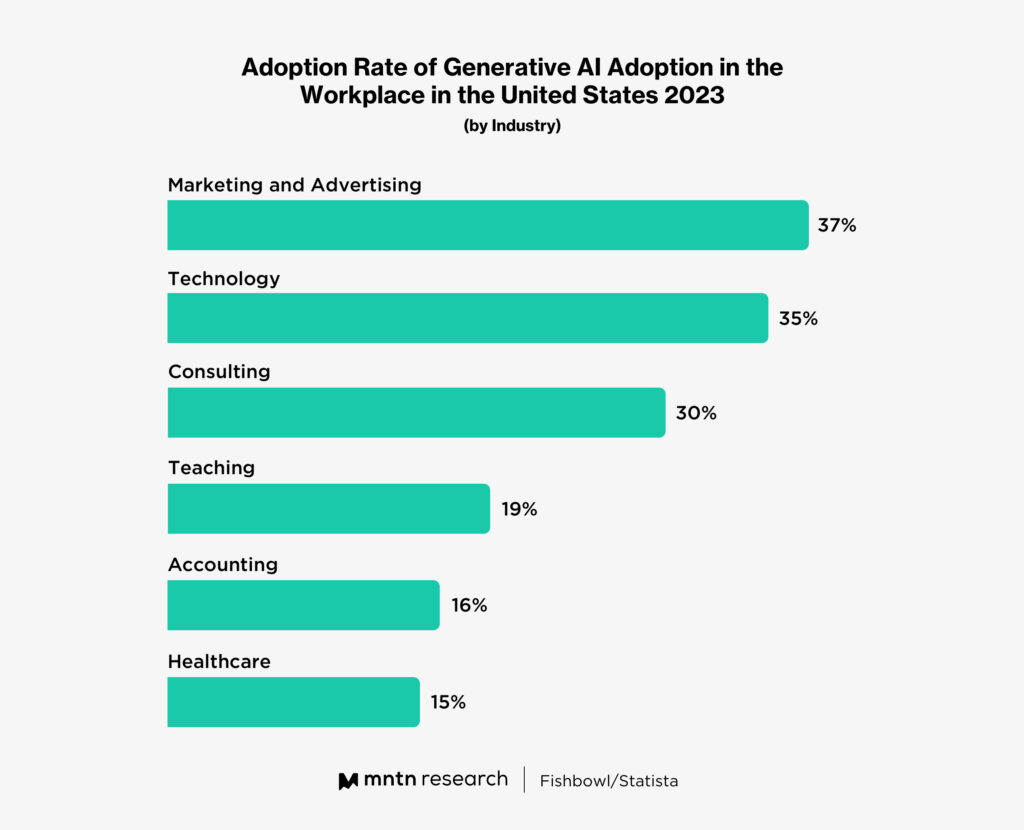
Here’s the thing though: artificial intelligence (let’s just call ‘em the machines for short) should not be used to replace the human touch within the creative process. Yes, all of our hearts leapt when we first saw those doomer-adjacent headlines heralding the end of human creativity. But if we were to make a prediction based on the history of new tech, many of these fears will likely be unwarranted. Because the machines aren’t here to replace us: they’re here to work with us. And we just need to be ready to work with them.
But how? How exactly can the machines help augment the creative process? That’s what we’re here to tell you.
The (New) Tools of the Trade
To illustrate why the machines won’t supplant creative marketers, I want to share with you a metaphor from our Director of Content and Research, Tim Edmundson.
As Tim described, if AI is a tool, think of it like a hammer. On its own, a hammer is still powerful and valuable. But the tool will not drive in a single nail until a human hand touches it. After all, it’s just an inanimate object that requires an outside force to make it work effectively.
But to go a step further with this metaphor, once you pick up that hammer you have a choice to make. You could grasp it tightly in your hand like a normal person, or you could casually drop it on the nail, hoping the weight of the tool will be the most effective way to use it. Let’s just say if you’re relying on gravity to drive that nail home, you’re going to quickly lose your job as foreman for Habitat for Humanity.
If the machines are the hammer, then marketers are the hand. Hammers are tools that can make your job a million times easier, but it won’t work to its full effect until you have a firm hold on that hammer, controlling exactly where it should go. And while you can drop the hammer on the nail and say “Job completed!” your final product will be so much better if you have a five-fingered death grip on that vital tool.
If someone isn’t holding the handle, or if you are just dangling it over a nail and letting it go hoping that it’ll produce quality work, then you’re going to be sorely disappointed with AI tools being your only creator.
So how can marketers use current generative AI tools to augment their creative process? Let’s look at a few ways to put it into practice.
Concept Brainstorms
As any writer knows, there’s nothing more debilitating than the blank page. This is where the machines can really come in handy. Tools like ChatGPT, Outwrite, and Notion.AI have quickly revolutionized the speed in which we ideate content. Now, with a few specific text prompts, we can generate a list of ideas to use as conceptual starting points, filling the blank page in an instant.
For example, say you are a subscription meal delivery service branching out into Connected TV. You want to run a brand awareness campaign to promote a new feature of your service. You know you want to target millennials and Gen Z, and you want to leverage the style of humor popular on TikTok. There’s a lot of different creative directions you can take, but if you feed this prompt into ChatGPT, you’ll get an assortment of options you can quickly refine and iterate on. Here’s an excerpt of what the machines gave me:
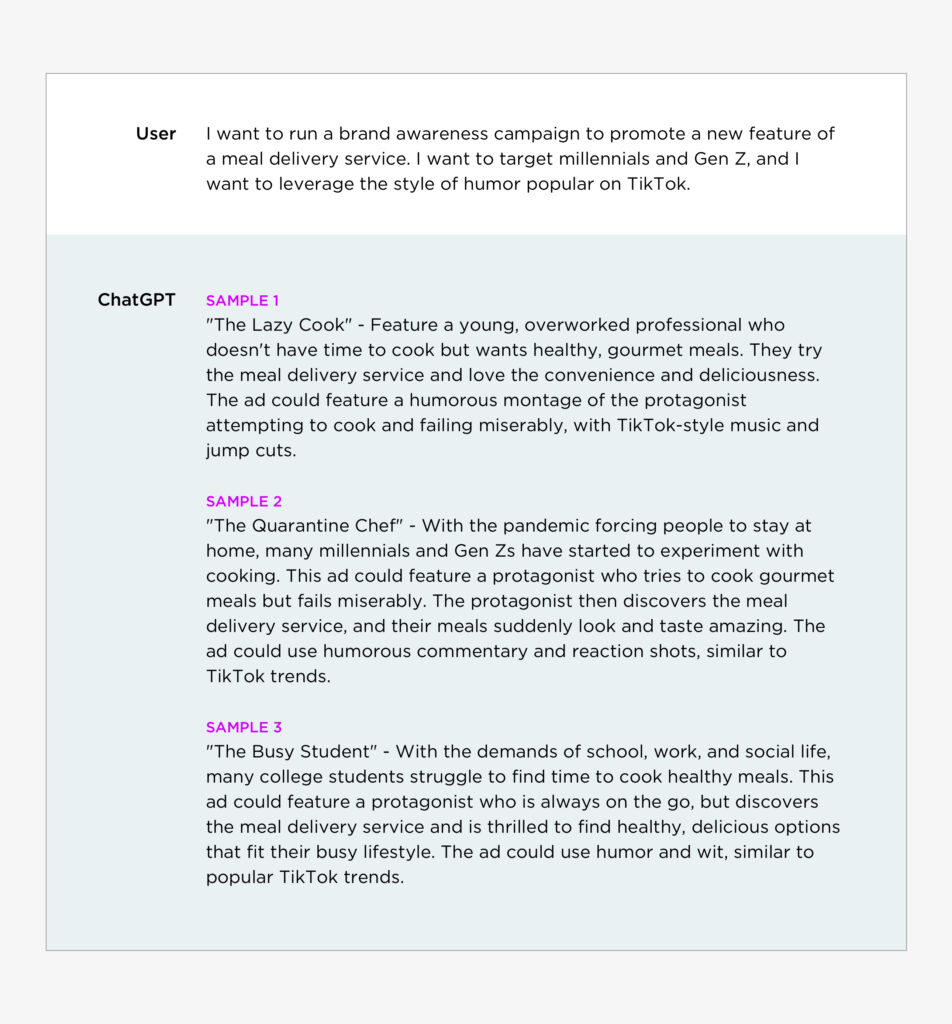
As you can see the machines gave me solid choices that I can use to brainstorm even more ideas. I hadn’t considered making each video focused on one type of person within the target audience, but it’s now given me the idea that I could create an entire series of videos focused on unique customer personas.
But here’s the one drawback of only relying on the machines to do the creative heavy lifting. In my prompt I specifically asked the machines to give me ideas that lean into TikTok’s style of humor. But as you’ll see in the responses, the machines didn’t really give me any tangible ideas. It can tell me “This ad could use humor popular on TikTok”, but it couldn’t tell me what that humor could actually look or sound like.
This is why you can’t afford to replace human creativity as artificial intelligence comes online. Generative AI only spits out what it has already crawled and consumed across the web. The ideas ChatGPT and the like produce are just reconfigurations of thoughts and concepts that already exist in different pockets of the internet.
So if you want your content to feel truly unique, or if you want to bring new ideas to the table (and to life) then you can’t afford to lose the human creative touch on your teams.
Writing Narrative
Just because all marketers want to be exceptional storytellers does not mean all marketers are actually exceptional storytellers. Sometimes you have a great hook, but have no idea where to go next. Other times you may have come up with a brilliant call-to-action, but aren’t sure the best way to build up to it. This is where AI language programs can be a big boon for crafting narrative: it can become your writing partner, helping you work out the story beats your ad needs to make an impact.
Let’s jump into another machine-driven example. I told ChatGPT that I wanted to create a video ad for a line of cosmetics. I provided an opening hook (“it starts with a person looking at their reflection in a makeup compact”) and an ending (“we see them spending a night on the town”). I then asked the machine to give me ideas for what could happen between the beginning and ending. Here are three suggestions it came back with:
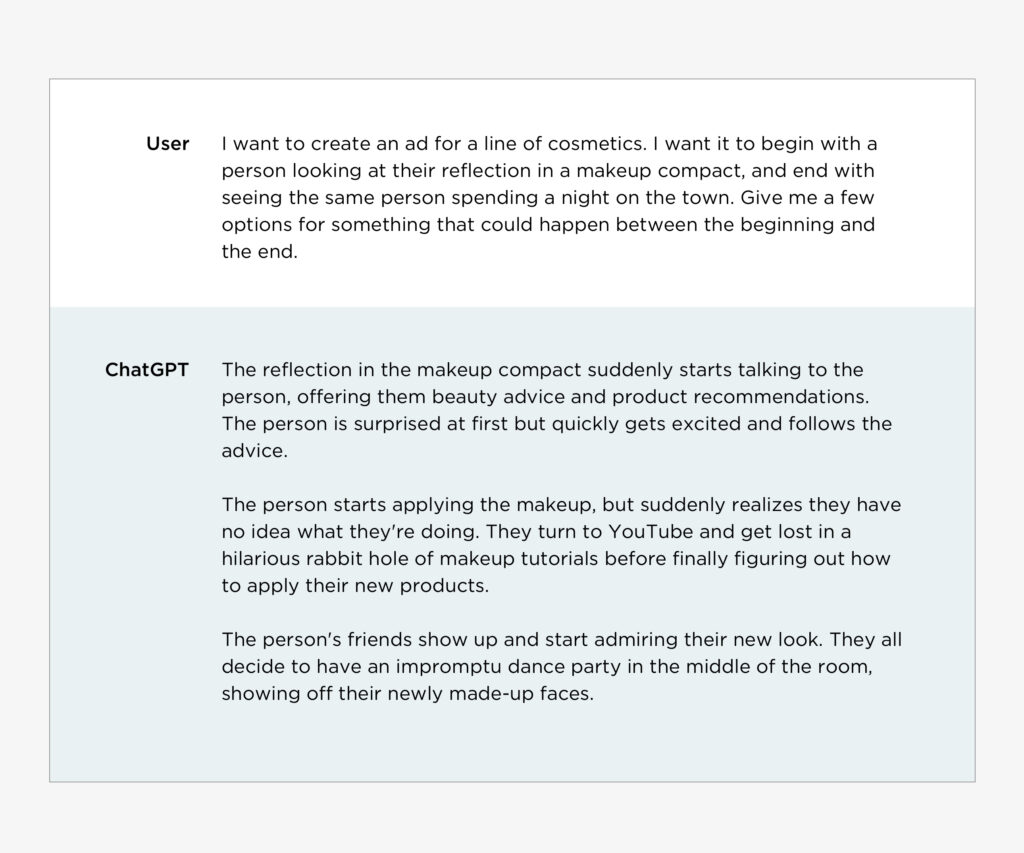
Some of the phrasing may be a little wonky, but the machine followed my instructions to a T, and gave me enticing suggestions for what could have been a very basic video.
But this continues to drill into our point that you still need creatives in charge of generating these concepts in concert with AI tools. Because while the above example used a rather straightforward prompt, let’s see what happens when we give it something a little more creative.
I told ChatGPT: “I’m working on a TV ad for a food delivery service with the goal of making new customers aware of our business in a funny, weird way. I know I want it to start with a dog in a pizza delivery costume, but I don’t know what the middle and ending could be. Could you give me a few options?”
Here’s an excerpt of what I got back:
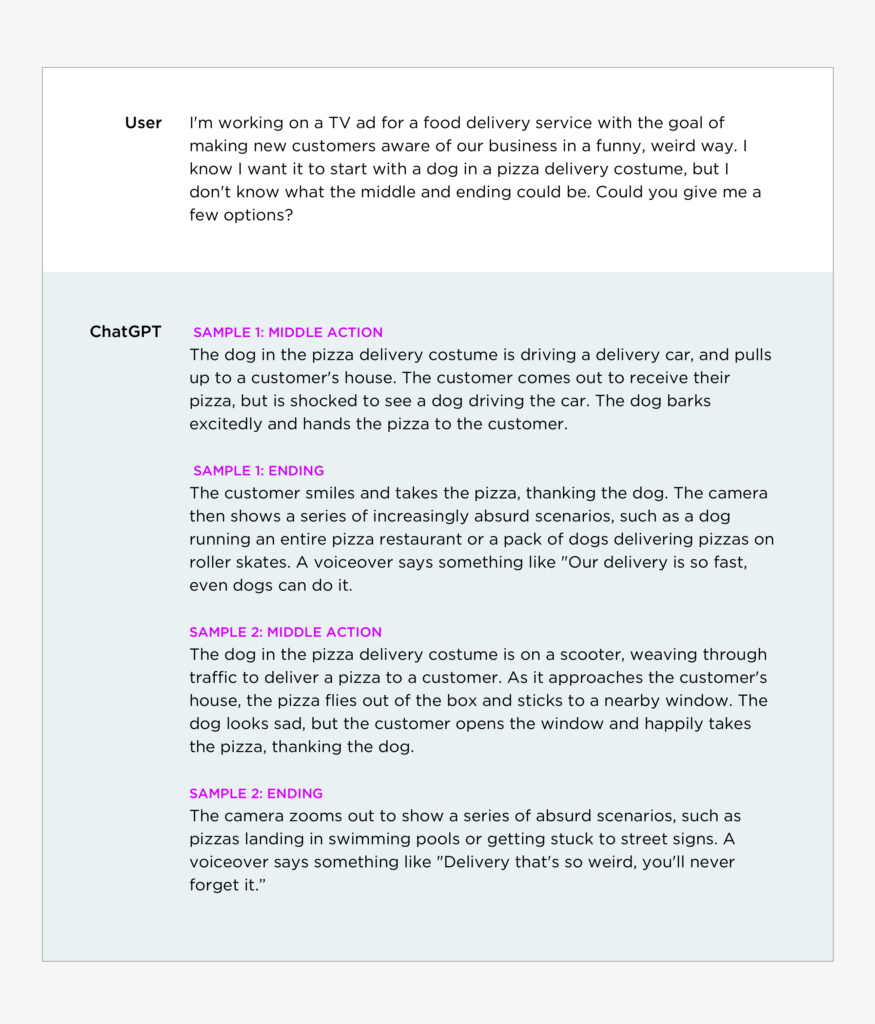
As you can see, because I explicitly asked for a strange scenario, it gave me back something exceptionally weird. If you are planning to employ AI tools within your creative process, you’ll get far more interesting results if you have a creative copywriter or designer still driving the creative vision of the campaign.
Quick Visualizations
I’m always impressed by our design team’s skills because I myself am terrible at creating any and all things visual art. That’s where something like DALL-E 2, Midjourney and other generative AI visual tools come in handy for more textual creatives like myself. The value these programs provide is that anyone can enter a simple text prompt and be given an almost instant visualization of that prompt.
Oftentimes these can produce wildly captivating images that can be used as a source of inspiration for marketers with a less than artistic eye. And with concise, descriptive text prompts, they can also theoretically be used as a tool to generate storyboards for video ads.
Storyboards are an essential part of any video production. A storyboard is essentially a visual representation of your script, laying out, scene by scene, the way your ad will visually look. So if you know your video ad will have three scenes, you can create a text prompt for each, using the resulting visuals as a starting place for what you may want your videos to ultimately look like.
This makes this style of Generative AI tool especially useful for smaller teams who do not have graphic designers or animators on staff, or who may not have the budget to hire a video production partner who can handle storyboards and visualizations. Let’s take that “pizza dog” concept ChatGPT helped me refine above. I fed a few simple prompts into Canva‘s text-to-image AI tool – dogs working in a pizza kitchen, dog hand delivering a pizza – to generate six images that could be used as preliminary storyboards. This is what I got back.
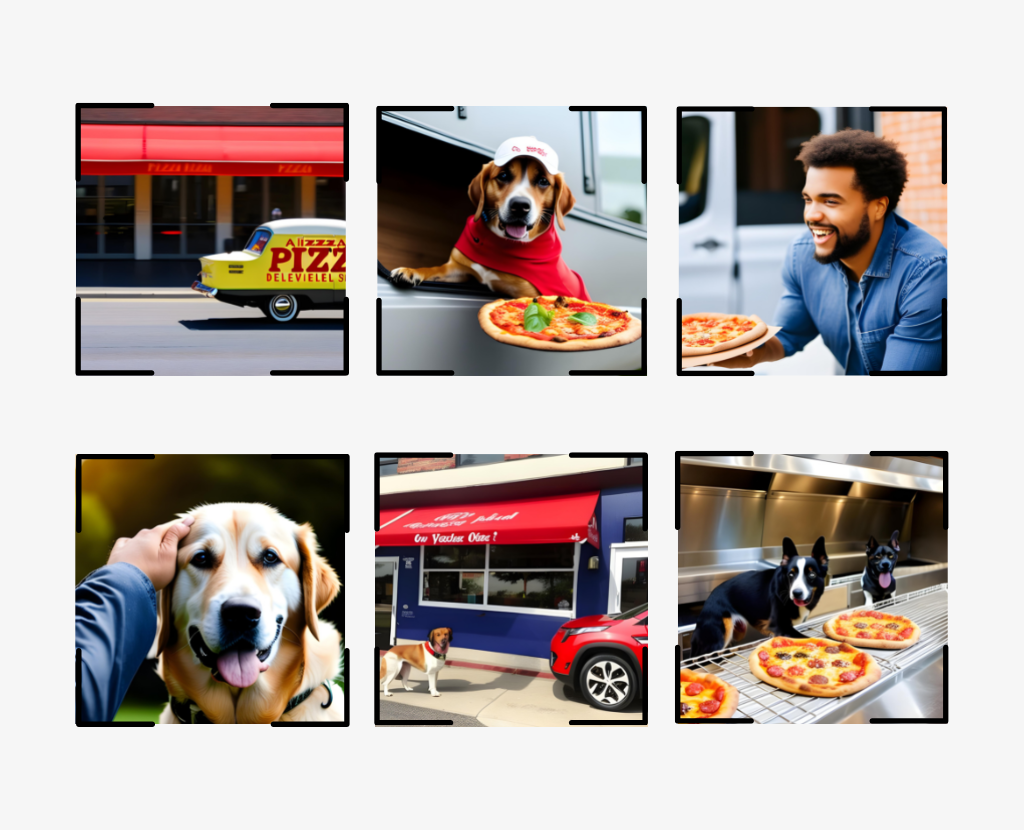
Despite the AI tool unintentionally making a couple of the dogs look a little unhinged, the results speak for themselves. These are fantastic, and easily produced, visual references to use as creative touchstones throughout the video production process.
We did want to note that while it’s recommended you integrate generative AI visual tools into your creative workflows, that does not mean you should rely on these same tools to create your final ad. Two recent surveys from Big Village support that suggestion.
One report discovered that only 19% of responding consumers found marketing and advertising content that used generative AI images appealing. Another survey on consumer attitudes towards the usage of generative artificial intelligence (AI) in social media advertising found an overwhelming 48% believe it should not be used, compared to 25% who believe it should be used.
End-to-End Video Production
As the machines evolve, so will their capabilities within the creative process.
Recently, Spectrum Reach announced a generative AI tool that would help small to midsize businesses make quick turn TV ads. The idea is that the AI tool would review a businesses social presence (and theoretically it’s website too) to churn out the ready-to-air ad with little to no input from the marketing team.
Sounds super intriguing, right? It’s making creative decisions based on key variables, and as the brand’s social presence grows, arguably their ads will get even better as it pulls new and interesting language from their digital presence.
But the thing is though, once you have that ready to air ad in your hand, how do you know that it will be effective, and not insipid? If you don’t have creative humans helping you with creative decisions, your content may feel banal, even if it was produced by something incredibly interesting.
Conclusion: What Does AI Think About Their Role in the Future of Creative?
I sent ChatGPT one final prompt asking the question on all marketer’s minds, “Will AI replace creative jobs?” This is what it told me:
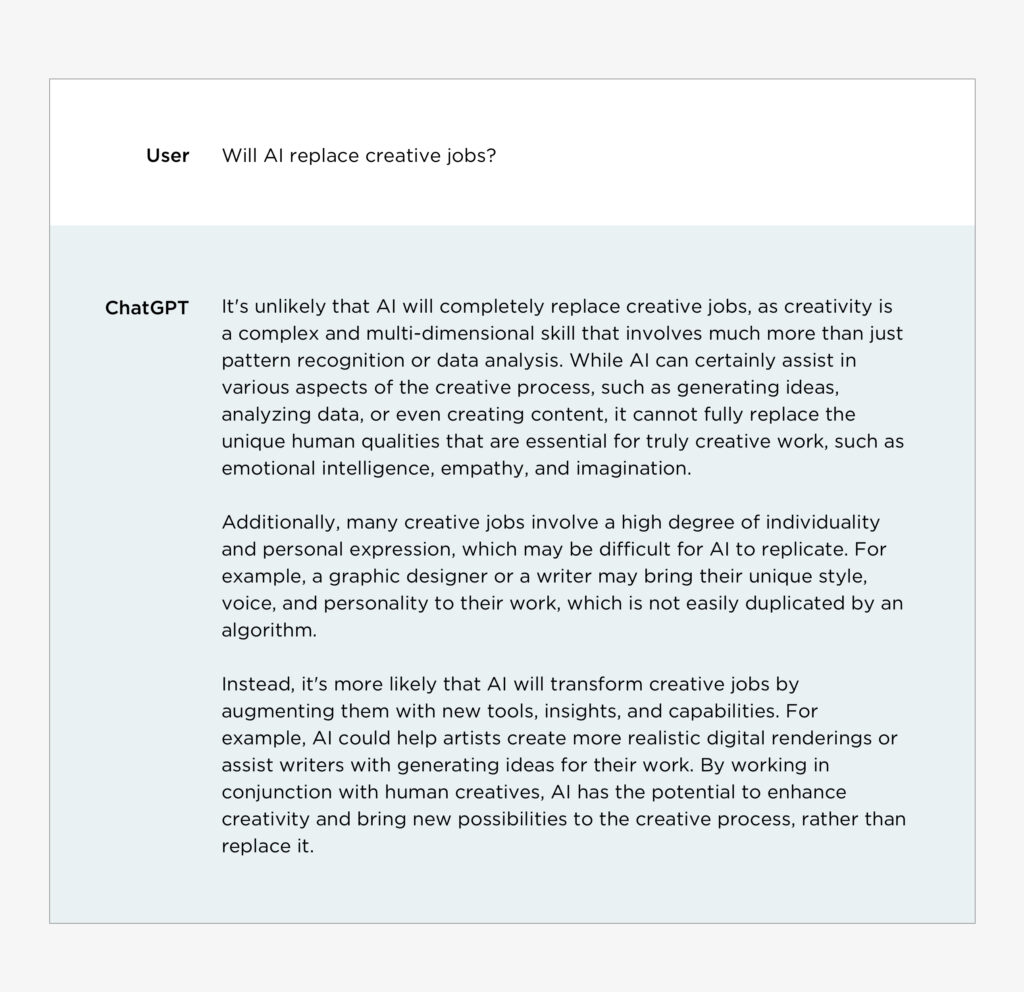
Out of the mouths of babes AI language models, amirite?
As ChatGPT just told us, AI technology is merely a new tool, not a replacement for your creative brain. Especially as AI continues to take off in the coming years, you will do yourself a disservice by not jumping on at the ground floor. If you’re afraid the machines are coming for your jobs, well, get on now and don’t give them a chance to replace you.
Subscribe to the MNTN Research Weekly
Sign up to receive a weekly feed of curated research, sent straight to your inbox.